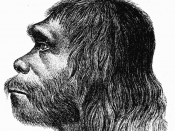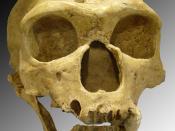Neanderthal was the name given to the prehistoric men who lived in Europe, and western and central Asia. They were discovered in 1856 in Neander Valley, near Düsseldorf, Germany and are the source for the caveman stereotype. The name Neanderthal comes from the gorge where scientists discovered a skullcap. It was the first remains to be found of this ancient people. They probably lived between 110,000 and 30,000 years ago. Since then, archaeologists have found approximately 30 skeletons.
Neanderthals had a large brain, much like modern man, with a capacity of about 1,500 cc, a strong upper body, a bulbous nose, and a prominent brow ridge. They were heavily built, but walked fully erect. When first discovered, it was thought that Neanderthal man walked with a stooped posture. It was later discovered that the specimen found was arthritic. They had heavy jaws, powerful teeth, and a sloping forehead. They were probably the first to develop some type of civilization forming into small groups for survival.
They developed weapons and defended themselves against other invading tribes. They had the ability to think and to adapt. Both sexes were treated equally with the sharing of hunting animals, gathering food and raising their children.
Neanderthal man made a number of crafted flint tools with many different uses. Judging from the hearths found at many sites, Neanderthals had mastered the art of making fire. Fossil bones show signs of old injuries that had healed, indicating the victim had been cared for. Some Neanderthal caves contain burial sites, indicating that Neanderthals were probably religious. The Shanidar cave in Iraq held the remains of a Neanderthal buried 60,000 years, with bunches of flowers. Several of the flowers discovered were species used today as herbal medicines. It is therefore possible that Neanderthals had an intricate culture, were...


